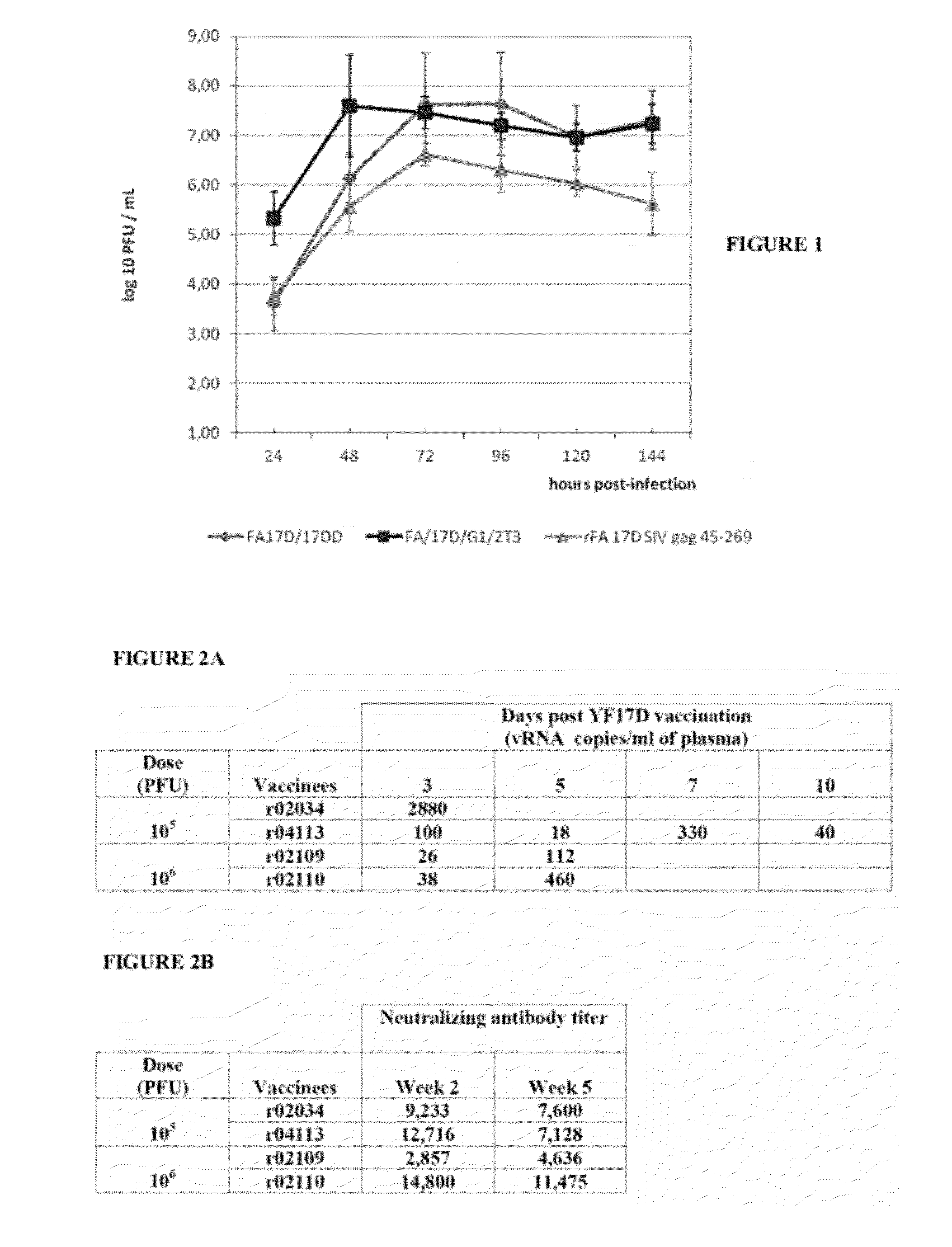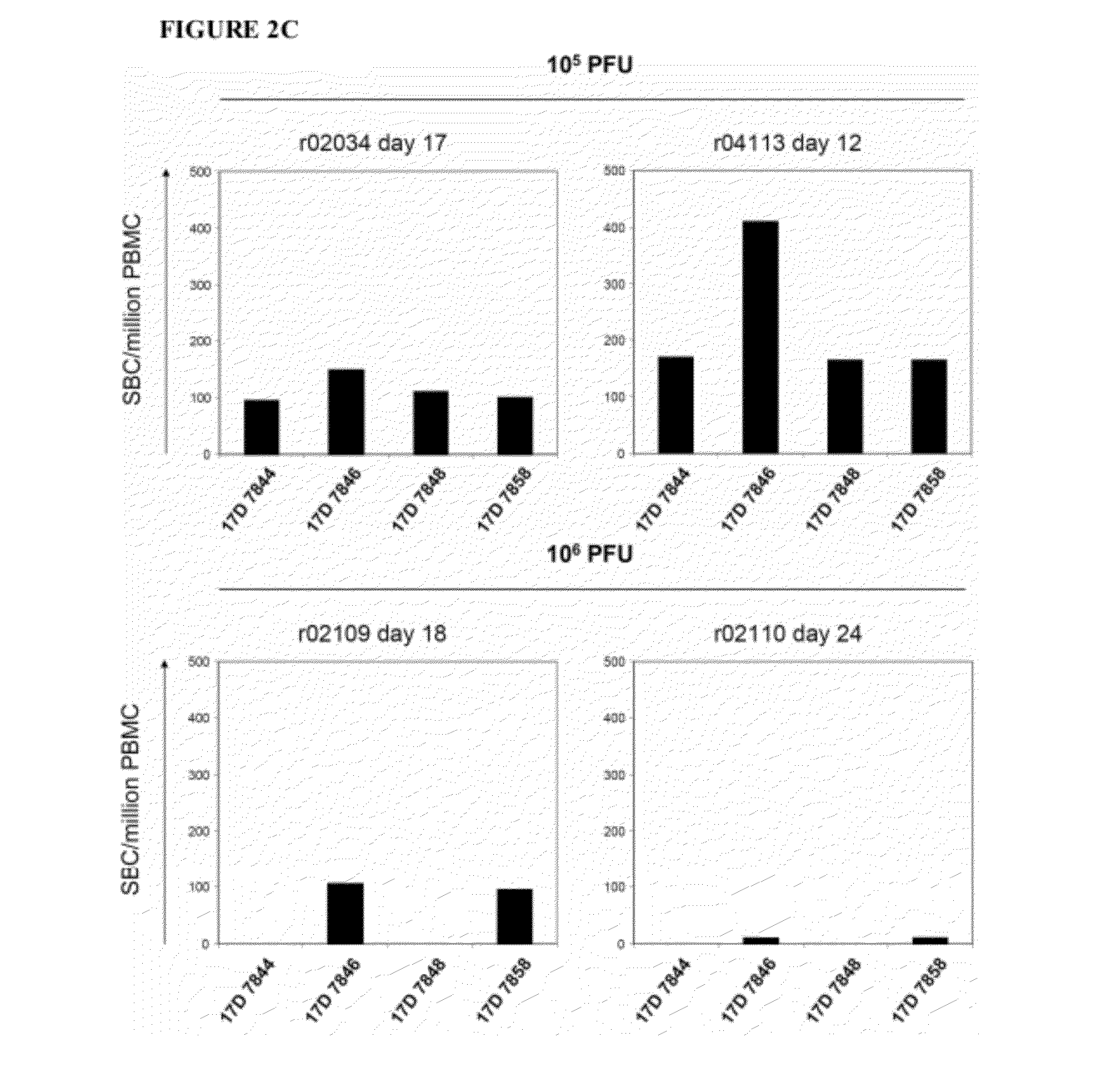Lentivirus vaccine based on the recombinant viral vaccine against yellow fever
a lentivirus and recombinant technology, applied in the field of lentivirus vaccine based on the recombinant viral vaccine against yellow fever, primate lentiviruses, can solve the problems of inability to reduce hiv infection or replication rate, efforts to broad induce reactive neutralizing antibodies, and enormous variability of envelope glycoproteins
- Summary
- Abstract
- Description
- Claims
- Application Information
AI Technical Summary
Benefits of technology
Problems solved by technology
Method used
Image
Examples
example 1
Proliferation Properties of Recombinant rYF17D / SIVGag45-269 In Vero Cells
[0068]The growth capacity of recombinant virus rYF17D / SIVGag45-269 was assessed and compared with other two viruses, YF 17DD and YF17D / G1 / 2 T3 vaccine (the latter corresponding to the parental vector virus, that is, heterologous insertion). Three independent experiments of virus growth in monolayers of Vero cells were performed. All experiments were performed in low MOI of 0.02 with densities of Vero cells of 62,500 cells per cm2.
[0069]The recombinant virus rYF17D / SIVGag45-269 presented a lower growth rate compared with the viruses of 17D vaccine, and had its peak at 72 hours after the infection, exhibiting a titer of 6.61±0.23 log 10 PFU / mL. FIG. 1 shows the viral growth curves in Vero cells. Cells were infected with YF 17D control (gray lozenges), YF17D / G1 / 2T3 virus (black squares), or with the recombinant virus rYF17D / SIVGag45-269 (gray triangles in MOI of 0.02). Each time point represents the mean titer obt...
example 2
Preliminary Immunological Studies of the YF17D Vaccine Virus Infection in Mamu-A*01-Positive Rhesus Monkeys
[0070]First, the YF17D vaccine virus was used to infect four Mamu-A*01-positive monkeys. The vaccine virus replicated in these four animals and induced neutralizing antibodies in all four monkeys by two weeks after vaccination (FIGS. 2A and 2B). To monitor the CD8+ T-cell immune response against YF17D, its proteome was scanned for peptides that might bind to Mamu-A*01 using algorithms (MHC Pathway) [14]. The 52 YF17D-derived peptides which were most likely to bind to Mamu-A*01, based on their predicted affinity for this MHC class I molecule, were synthesized. IFNy ELISPOT assay was used to screen these peptides in YF17D-infected animals, and four Mamu-A*01-binding peptides: 17D 7844 (LTPVTMAEV; LV91285-1293), 17D 7846 (VSPGNGWMI; V193250-3258), 17D 7850 (MSPKGISRM; MM92179-2187), and 17D 7858 (TTPFGQQRVF; TF102853-2863) were recognized in vivo (FIG. 2C). Using a previously repo...
example 3
Immunogenicity of rYF17D / SIVGag45-269 in Rhesus Monkeys
[0071]In the following step, the YF17D vaccine virus was engineered to express amino acids 45-269 of SIVmac239Gag (rYF17D / SIVGag45-269) by inserting a yellow fever codon-optimized sequence between the genes encoding the viral proteins E and NS1. This recombinant virus replicated and induced neutralizing antibodies in mice (data not shown). The rYF17D / SIVGag45-269 construct was then tested in six Mamu-A*01-positive Indian rhesus monkeys. Evidence for the viral replication of rYF17D / SIVGag45-269 was found for five of these six monkeys (FIG. 3A). Neutralizing antibodies were evident at two weeks after vaccination (FIG. 3B. [sic] A single immunization with rYF17D / SIVGag45-269 induced antigen-specific CD8+ T cells in five out of the six Mamu-A*01-positive monkeys (FIG. 3C). This recombinant virus also induced CD8+ T-cell activation in the majority of the vaccinated animals (FIG. 3D). The sixth monkey (r04091) required a booster dose ...
PUM
| Property | Measurement | Unit |
|---|---|---|
| time | aaaaa | aaaaa |
| time | aaaaa | aaaaa |
| time | aaaaa | aaaaa |
Abstract
Description
Claims
Application Information
 Login to View More
Login to View More - R&D
- Intellectual Property
- Life Sciences
- Materials
- Tech Scout
- Unparalleled Data Quality
- Higher Quality Content
- 60% Fewer Hallucinations
Browse by: Latest US Patents, China's latest patents, Technical Efficacy Thesaurus, Application Domain, Technology Topic, Popular Technical Reports.
© 2025 PatSnap. All rights reserved.Legal|Privacy policy|Modern Slavery Act Transparency Statement|Sitemap|About US| Contact US: help@patsnap.com



